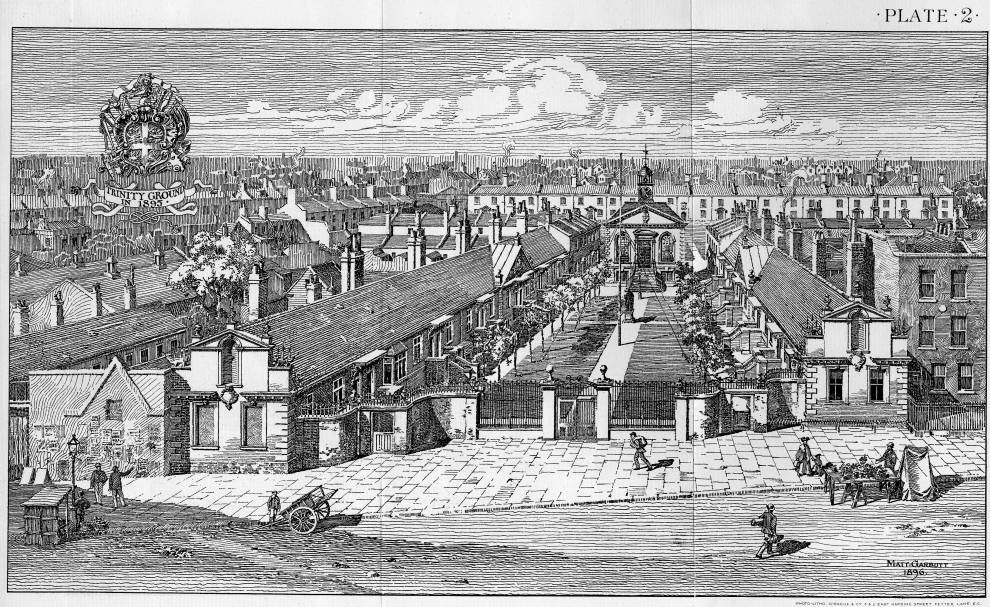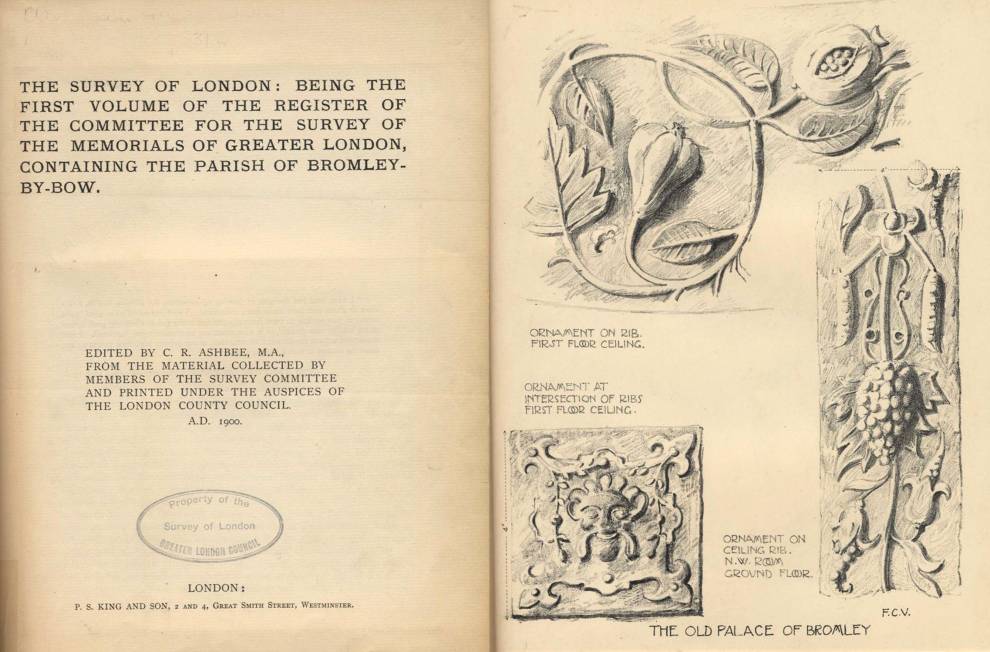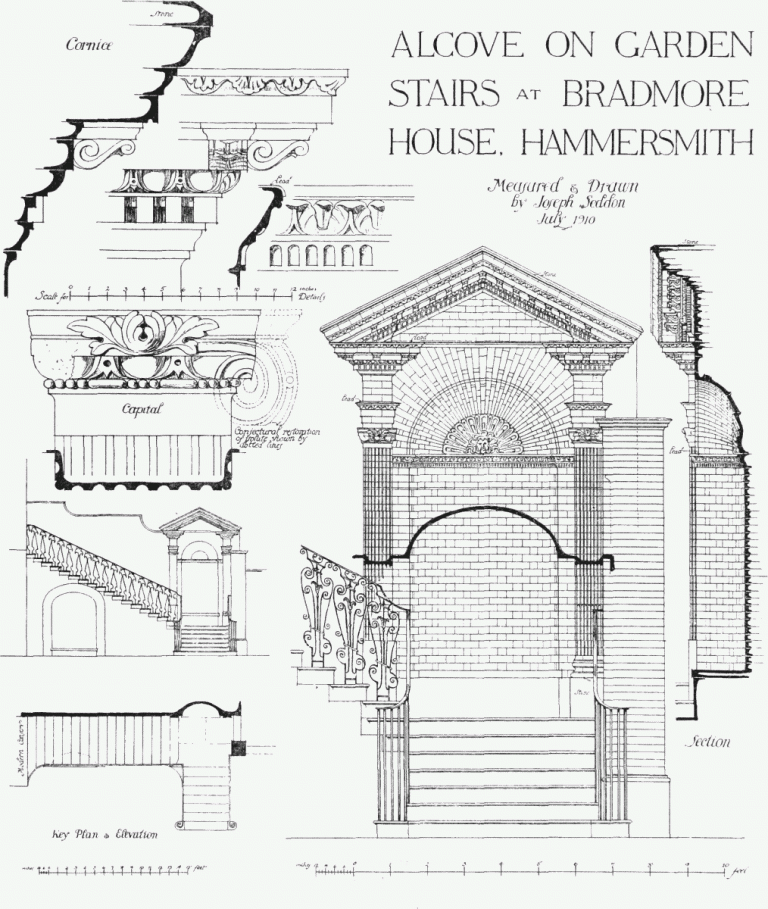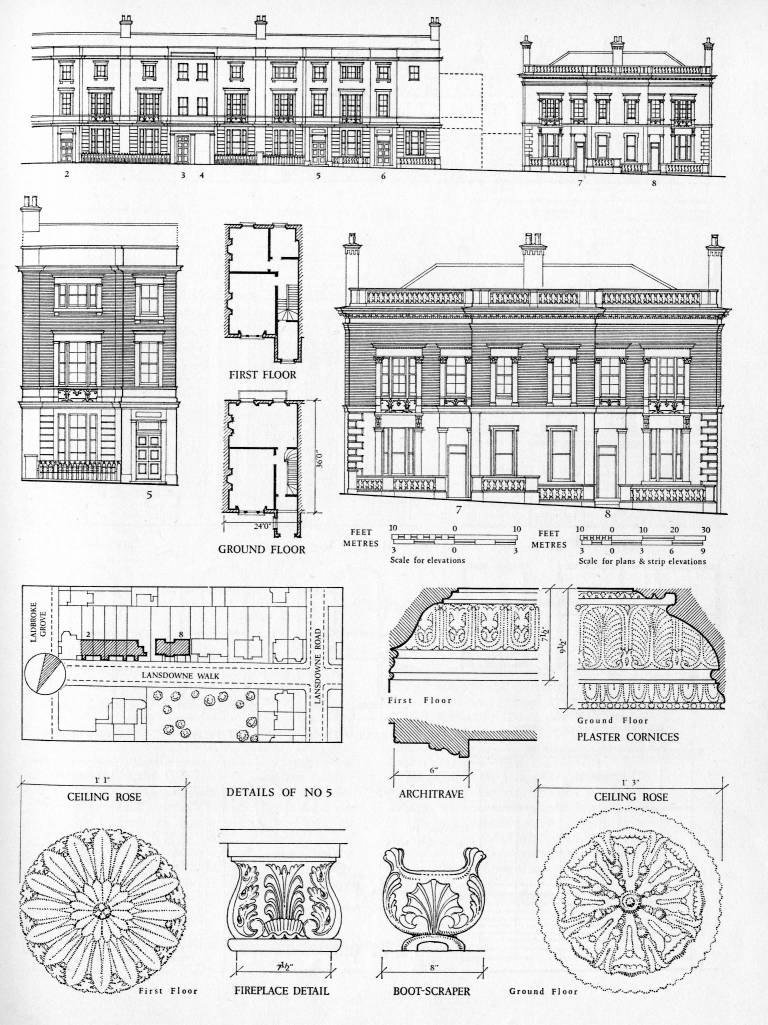
How the Survey came about
In the spring and early summer of 1894, the young Arts and Crafts architect Charles Robert Ashbee (1863–1942) was the moving spirit in setting up an action group to help stem the destruction of London’s historic buildings and monuments. The ‘Committee for the Survey of the Memorials of Greater London’ was the latest in a series of initiatives in response to the rising heritage toll taken by improvement schemes and piecemeal redevelopment.
At national level, these included the Society for the Protection of Ancient Buildings, founded in 1877, the National Trust, founded in 1895, and the National Photographic Record Association of 1897. In London, an early straw in the wind was the Society of Arts’ commemorative plaque scheme, the precursor of the modern Blue Plaques. The first was put up in 1867.
A counter-blow to unchecked speculative building, a large part of Hampstead Heath had been bought by the Metropolitan Board of Works in 1871 to save it for the public. The Society for Photographing the Relics of Old London was started in 1875, the London Topographical Society in 1880. In 1878 the Corporation of London dismantled Wren’s Temple Bar, but saved the stones for eventual re-erection elsewhere.
Historic structures of all kinds were then almost entirely without statutory protection in the UK, though the Ancient Monuments Act of 1882 pointed the way to future legislation. They had never been systematically listed or investigated – what was known of them, beyond the bounds of common knowledge or tradition, came down largely to antiquarianism and often ill-informed attribution. Whole swathes of London were self-evidently ‘old’ but essentially unknown, untouched by the hands of restorers and prey to demolition, alteration or neglect. Remarkable discoveries could be made, in the most picturesque as well as the most prosaic of places.
The formation of Ashbee’s committee was sparked by one particular incident: the destruction, in ignorance, of the so-called Old Palace in Bromley-by-Bow in east London, a royal hunting-lodge of about 1600, for the site of a new Board School. Just a ceiling and some panelling were eventually saved, after an outcry, for what is now the V&A.
The Old Palace episode underlined the need for some kind of list of monuments. This was the specific aim of the Ashbee committee. A descriptive ‘register’ was to be compiled by volunteers, parish by parish, of monuments and buildings of interest dating from before 1800, supplemented by an ‘emergency list’ of any under imminent threat of damage or destruction, and monographs on individual buildings deserving fuller treatment than could be allotted to them in the summary register itself.
To start with, activity was to focus on the east of ‘Greater London’ (a term with no official meaning at that time), extending well into Essex. A less opportunistic initiative would probably have started with the innermost historic core, in the City and along the Thames to Westminster. But Ashbee, as the founder of the Guild and School of Handicraft, was already based in the industrial East End, at Essex House, an early eighteenth-century mansion in Mile End Road where the guild had its workshops and printing press. Moreover, he was keen to link the preservation of historic monuments and buildings with out-of-town housing developments or garden suburbs for the working class, using as nuclei historic houses and their estates.
Consequently the Survey began by combing the area 20 miles east and north of Aldgate pump, and south to the Thames. Later, when Ashbee had moved to Cheyne Walk, the focus of activity moved west with him, to Chelsea and Hammersmith, but rural Middlesex and Surrey remained outside the Survey’s remit, apart from the case of houses such as Swakeleys, west of London in still-rural Middlesex, which became the subject of timely descriptive monographs.
There was a strong element of protest against demolition in the committee’s agenda, and early on a major victory was won when the seventeenth-century Trinity House almshouses in Mile End Road were saved from redevelopment through a campaign led by Ashbee. The first Survey of London publication, a monograph describing the almshouses and containing a manifesto for the Survey, was written by him and printed at Essex House in 1896.

The role of the London County Council
The Survey of London was not initially thought of as a long-term project, and if enough energy and resources had been available at the start it is possible that the register might have been completed by the First World War. Its original purpose, after all, was essentially practical, and it was certainly not intended as an ongoing project of academic character.
But it was not long before that original purpose was becoming lost. Indeed, in 1909 the architect Walter Hines Godfrey (1881–1961) claimed, in the preface to Volume 2, his study of riverside Chelsea between the Old Church and the Royal Hospital, that the Survey was primarily illustrative – the text ‘must be understood to be subservient to the Plates, which actually constitute our Survey of Chelsea’.
This was clearly not true, and perhaps Godfrey was taking a defensive position, as if he was not only aware of possible shortcomings in the work but of the potential vastness of a project where the plates became subservient to the text. Even so, he must have been well aware that the register was conceived as a compilation of information, and that historical significance and interest went far beyond what could be drawn or photographed, and therefore that much could only be described in words.
Godfrey was defensive also about the lapse of time since the appearance of the first parish volume nearly a decade before, though he could point to the production of several monographs on individual buildings in the interim. The fact was that it had proved quite impossible to sustain the necessary rate of progress, and drum up the requisite funds for publication, given the Survey Committee’s volunteer basis and small subscriptions, and the project would probably have petered out had the London County Council not intervened.
The council, set up to supersede the Metropolitan Board of Works just five years before the Survey Committee was started, developed its own positive approach to historic buildings in the 1890s and 1900s, initially through the efforts of its sometime chairman Sir John Lubbock (later Lord Avebury, 1834–1913), who was behind the Ancient Monuments Act. LCC cooperation with the Survey Committee came about largely thanks to its statistician, later the Clerk of the Council, the historian and folklorist Sir Laurence Gomme (1853–1916). The LCC had paid for the publication of Bromley-by-Bow in 1900, and was to play an increasingly important role in the Survey’s future.
Meanwhile, Ashbee’s influence waned after he moved with his Guild to the Cotswolds in 1902, and Ernest Godman, his chief assistant in his architectural practice and the energetic Secretary of the Survey Committee, died young in 1906. This left a void which was to be filled by Godfrey and two others who with him steered the Survey Committee for many years and were responsible for much of its published work: the artist and historian Philip Norman (1842–1931) and the architect Percy Lovell (1877/8–1950).
The committee paid for the publication of Godfrey’s first Chelsea volume in 1909, but by that time the LCC was effectively preparing to take over the Survey as a project worthy of official sponsorship and direction. In any case it was clear that the LCC’s activities would otherwise lead to the duplication of historic-building recording by the two bodies.
In 1910 a formal agreement for cooperative working was reached. A Joint Publishing Committee was to be set up to direct the Survey’s work, and successive parish volumes would be prepared alternately by the LCC and the Survey Committee, which was also to carry on with its monographs. Publication costs were met by the council.
This arrangement worked quite well for many years, but with growing divergence between the volumes produced by the two bodies, the LCC and its professional staff developing a fuller, more expository approach to the subject increasingly at odds with the more formulaic and sometimes antiquarian work of the unpaid historians under the Survey Committee.
The committee’s productions, for instance, were marked by a fondness for heraldry, lists of office-holders of institutions, and full transcriptions from gravestones and memorials – often taking up a great deal of space. Some of the committee’s authors, too, were keen to dwell on details from medieval sources back to the Domesday Book, little if any of it relatable to existing fabric and addresses.
Frank Marcham, an antiquarian book-dealer who worked on the St Pancras volume dealing with Highgate Village with his brother William McBeath Marcham, was openly hostile to established and professional historians, even producing a vexatious pamphlet setting out to expose the ‘ignorance’ of the historians F. M. Stenton and C. L. Kingsford on the subject of Norman London.
The LCC’s more academic tendency was apparent as far back as the early 1920s, when it produced The Parish of St. Leonard, Shoreditch (Volume 8). Unbridgeable gaps in taxation records made it impossible to tie up known buildings and sites with early lists of householders. Rather than persist with the standard-form approach used hitherto, the large amount of more generalized historical information gathered was used to produce a long and discursive introduction to the area as a whole.

In time the Survey generally was to develop a reputation for a diverse approach, combining the formal recording and description of buildings with anecdotal details, often social or biographical.
In 1936, the Evening Standard’s reviewer of Volume 17, St Pancras Part 1: The Village of Highgate, one of the Survey Committee’s volumes, was pleased to note that this was ‘not a mere catalogue of the architectural features of the houses of Highgate; it contains some interesting and amusing and sometimes almost scurrilous comments on the personalities of the village’.
Much of this material was drawn from the Court Leet records of the manor of Cantelowes, or from newspapers and magazines – such as the story of Mrs Bromwich, a rich widow of 80, who married her 25-year-old coachman in 1789 after her children’s attempt to buy him off failed. To some extent, the choice of material for inclusion was simply a matter of what could be found, at a time when so much source material was either unavailable, unknown, or too time-consuming to make use of.
Godfrey’s 1909 injunction that the Survey was primarily illustrative proved completely unsustainable, and the books became closer to a part-work history of London than to the originally conceived register. The register, in any case, was superseded by the National Buildings Record, set up in 1941 with Godfrey as director, and the Lists of Buildings of Architectural and Historic Interest drawn up under the Town and Country Planning Acts of 1944 and 1947.
After the Second World War it was evident that the Survey Committee was running out of steam, and the third and fourth St Pancras volumes (1949 and 1952) needed help from the LCC to be completed. In 1953 the Survey Committee was wound up, and the LCC took over the Survey entirely, with a new, full-time general editor, the historian Francis Sheppard (1921–2018).
This accelerated the process which had already been taking place, whereby the volumes became increasingly concerned with various aspects of the history of localities and their buildings, moving away from a highly selective descriptive study of individual monuments.
The original cut-off date of 1800 had long been abandoned, but the first volume researched and written under the new regime, on Southern Lambeth, took the Survey far from the historic core of London and into largely Victorian suburbia. The north end of the parish had been covered a few years earlier, along with part of Southwark, to deal with the topical subject of the South Bank, where the Festival of Britain had been centred.
Southern Lambeth (Volume 26) was a significant departure, challenging the definition of what was conventionally regarded as historic building (and therefore to some extent arguably at odds with the Ashbee-led initiative of half a century before), but fully in tune with emerging trends on the subject of taste and conservation – it was published in 1956, just a couple of years before the formation of the Victorian Society and the start of widespread serious appreciation of hitherto despised Victorian art, architecture and design. Coverage was still very selective by the standards of later volumes even so.
Subsequently, the powers at the LCC required the Survey to focus on the central, historic core of London, above all on areas where historic fabric was known to be under real threat, resulting in volumes on Spitalfields and a large part of the West End including St James’s, Covent Garden and Soho.
The Greater London Council and after
In the middle of this productive period, and belatedly reflecting the expansion of London since the late nineteenth century, in 1965 the LCC was replaced by the GLC. But although the new body’s remit covered a vast area, the Survey continued to work within the obsolete boundary of the old County of London, and has done so ever since. With certain exceptions, it has also remained tied to the civil parish boundaries as they were when the Survey began in 1894. With the abolition of the GLC in 1986, the Survey was transferred to the Royal Commission on the Historical Monuments of England (RCHME), originally set up in 1908, and responsible for producing a formal county by county inventory of the national built heritage.
From the late 1960s, the Survey embarked on what was to become a four-part survey of Kensington. While this included the Albert Memorial, Albert Hall and the South Kensington Museums financed from the proceeds of the 1851 Great Exhibition, its biggest impact was probably in the study of classic Victorian suburban speculative building development. The first Kensington volume, Northern Kensington (1973) gives an unsurpassed account of the interrelationship of landowner, architect, builder, lawyer and mortgagee operating the long-lease system of development. But again, it remains very selective, and the notorious Rillington Place, for instance, did not receive even a mention.
Many accounts of notable individual buildings are by present standards brief or even perfunctory. However, with Southern Lambeth, and more so with Kensington, the Survey became increasingly discursive and analytical in its approach, refining and developing the methodology of urban and suburban history pioneered at Leicester University by Professor H. J. Dyos. At the same time, formal architectural descriptions, which harked back to the early emphasis on illustration and inventorizing (as well as to the still-persisting format of the official Historic Building lists), were largely abandoned. This freed up more space for historical and thematic exposition.

In the late 1970s, the Survey, by invitation, began a study of the Grosvenor Estate in Mayfair, to mark the Estate’s bicentenary, involving work on some of the grandest houses in London. Subsequently, in the mid-1980s, under a new general editor, the conservationist and historian Hermione Hobhouse (1934–2014), it turned its attention to the East End, specifically to the Docklands parish of Poplar.
Begun under the GLC, this study was completed under the RCHME with the publication of Poplar, Blackwall and the Isle of Dogs in 1994, plus a spin-off publication Docklands in the Making: The Redevelopment of the Isle of Dogs, 1981–1995 (1995). This was during the peak years of frenzied and contentious regeneration under the London Docklands Development Corporation, and the result was a uniquely inclusive study looking at both historical building, much of it demolished or soon to be demolished, and the brand-new.
Knightsbridge (2000) marked a brief return to the relatively settled building fabric of west London and was in fact a long-intended adjunct to the Kensington volumes. South and East Clerkenwell and Northern Clerkenwell and Pentonville (2008) describe a large area adjoining the City of London, encompassing much eighteenth and early nineteenth-century suburban development as well as a former heartland of specialist manufacturing industries such as clockmaking. These were begun while the Survey was still part of the RCHME, and during the same period (1986–99) the Survey took on a number of projects in addition to the Survey series, including a study of London coroner’s courts, part of the RCHME’s survey of hospitals (published in 1999 as English Hospitals, 1660–1948, and a survey of nonconformist places of worship in the Borough of Islington (published in 1992 as Islington Chapels).
The monograph series was an important part of the ‘amateur’ side of the Survey, and was particularly kept going by Walter Godfrey, with whose last study, The College of Arms, the series officially came to an end in 1963. But it was revived to mark the abolition of the Greater London Council with a volume on County Hall, published in 1991, and subsequently the Charterhouse, on account of its size and complexity, was also dealt with as a separate monograph, published in 2010, rather than as part of the parish volumes on Clerkenwell.
In the early days, the Survey’s task was to find and describe historic monuments, at a time when they were to a large extent unknown and unexplored but readily defined as such once found. Definitions have since expanded to encompass almost anything, and there is a general recognition of the holistic nature of the built environment and its historical and cultural significance. Successive volumes show a trend towards a firmer and broader base of historical research, leavened by anecdotal information and always an appeal to the general reader rather than just the specialist – a legacy partly of amateur origins, and perhaps more so of the LCC’s democratic commitment to Londoners generally.
From 1999 the Survey of London was run by English Heritage, which took over the RCHME. Since 2013 it has been part of The Bartlett School of Architecture at UCL, where it has a major teaching and research role in addition to the continued production of the Survey of London series.
 Close
Close

